The Complete Genome Sequence, Molecular Detection, and Anatomical Analysis of Hibiscus Chlorotic Ringspot Virus Infecting Hibiscus rosa-sinensis in Peninsular Malaysia
Abstract
1. Introduction
2. Materials and Methods
2.1. Plant Material
2.2. RNA Extraction
2.3. RNA Sequencing
2.4. Computational and Phylogenetic Analysis
2.5. Primer Design for Molecular Detection
2.6. cDNA Synthesis and RT-PCR
2.7. Light Microscopy
2.8. Scanning Electron Microscopy
3. Results
3.1. The Nucleotide Sequence of HCRSV-Malaysian Isolate
3.2. Detection of the HCRSV Using RT-PCR
3.3. Anatomical and Morphological Analysis of the H. rosa-sinensis Leaf
3.3.1. Transverse Sections of the Leaf Lamina
3.3.2. Transverse Sections of the Petiole
3.3.3. Transverse Sections of the Midrib
3.3.4. Micromorphological Analysis of the Leaf Lamina of H. rosa-sinensis
4. Discussion
5. Conclusions
Author Contributions
Funding
Data Availability Statement
Conflicts of Interest
References
- Afiune, L.A.F.; Leal-Silva, T.; Sinzato, Y.K.; Moraes-Souza, R.Q.; Soares, T.S.; Campos, K.E.; Fujiwara, R.T.; Herrera, E.; Damasceno, D.C.; Volpato, G.T. Beneficial effects of Hibiscus rosa-sinensis L. flower aqueous extract in pregnant rats with diabetes. PLoS ONE 2017, 12, e0179785. [Google Scholar] [CrossRef] [PubMed]
- Ganesan, S.; Sabran, S.F.; Mazlun, M.H. Plant Diversity Assessment and Traditional Knowledge Documentation of Home Gardens in Parit Raja, Batu Pahat, Johor. In Proceedings of the IOP Conference Series: Earth and Environmental Science, Moscow, Russia, 27 May–6 June 2019; Volume 269. [Google Scholar]
- Khan, I.M.; Rahman, R.; Mushtaq, A.; Rezgui, M. Hibiscus rosa-sinensis L. (Malvaceae): Distribution, Chemistry and Uses. Int. J. Chem. Biochem. Sci. 2017, 12, 147–151. [Google Scholar]
- Khristi, V.; Patel, V.H. Therapeutic Potential of Hibiscus rosa-sinensis: A Review. Int. J. Nutr. Diet. 2016, 4, 105–123. [Google Scholar] [CrossRef]
- Missoum, A. An update review on Hibiscus rosa sinensis phytochemistry and medicinal uses. J. Ayurvedic Herb. Med. 2018, 4, 135–146. [Google Scholar] [CrossRef]
- Pourrahim, R.; Ghobakhlo, A.; Farzadfar, S. Biological and molecular detection of Hibiscus chlorotic ringspot virus infecting Hibiscus rosa-sinensis in Iran. Phytopathol. Mediterr. 2013, 52, 528–531. [Google Scholar] [CrossRef]
- Ramos-González, P.L.; da Costa-Rodrigues, M.; Potsclam-Barro, M.; Chabi-Jesus, C.; Banguela-Castillo, A.; Harakava, R.; Kitajima, E.W.; Freitas-Astúa, J. First genome sequence of an isolate of hibiscus chlorotic ringspot virus from the Western hemisphere. Trop. Plant Pathol. 2020, 45, 153–158. [Google Scholar] [CrossRef]
- Brunt, A.A.; Barton, R.J.; Phillips, S.; Lana, A.O. Hibiscus latent ringspot virus, a newly recognised virus from Hibiscus rosa-sinensis (Malvaceae) in western Nigeria. Ann. Appl. Biol. 1980, 96, 37–43. [Google Scholar] [CrossRef]
- Adkins, S.; Kamenova, I.; Chiemsombat, P.; Baker, C.A.; Lewandowski, D.J. Tobamoviruses from hibiscus in Florida and beyond. Acta Hortic. 2006, 722, 65–70. [Google Scholar] [CrossRef]
- Kitajima, E.W.; Rodrigues, J.C.V.; Freitas-Astua, J. An annotated list of ornamentals naturally found infected by Brevipalpus mite-transmitted viruses. Sci. Agric. 2010, 67, 348–371. [Google Scholar] [CrossRef]
- Srinivasan, K.G.; Narendrakumar, R.; Wong, S.M. Hibiscus virus S is a new subgroup II tobamovirus: Evidence from its unique coat protein and movement protein sequences. Arch. Virol. 2002, 147, 1585–1598. [Google Scholar] [CrossRef]
- Waterworth, H.E.; Lawson, R.H.; Monroe, R.L. Purification and Properties of Hibiscus Chlorotic Ringspot Virus. Phytopathology 1976, 66, 570–575. [Google Scholar] [CrossRef]
- Mitrofanova, I.V.; Zakubanskiy, A.V.; Mitrofanova, O.V. Viruses infecting main ornamental plants: An overview. Ornam. Hortic. 2018, 24, 95–102. [Google Scholar] [CrossRef]
- Singh, B.P.; Srivastava, K.M.; Raizada, R.K. Viruses of Ornamental—Identification and Diagnosis. In Horticulture—New Technologies and Applications; Springer: Dordrecht, The Netherlands, 1991; pp. 321–328. ISBN 978-94-011-3176-6. [Google Scholar]
- Huang, M.; Koh, D.C.; Weng, L.J.; Chang, M.L.; Yap, Y.K.; Zhang, L.; Wong, S.M. Complete nucleotide sequence and genome organization of hibiscus chlorotic ringspot virus, a new member of the genus Carmovirus: Evidence for the presence and expression of two novel open reading frames. J. Virol. 2000, 74, 3149–3155. [Google Scholar] [CrossRef]
- Jones, D.R.; Behncken, G.M. Hibiscus Chlorotic Ringspot, a Widespread Virus Disease in the Ornamental Hibiscus rosa-sinensis. Australas. Plant Pathol. 1980, 9, 4–5. [Google Scholar] [CrossRef]
- Koh, D.C.-Y.C.-Y.; Liu, D.X.; Wong, S.-M.S.-M. A Six-Nucleotide Segment within the 3′ Untranslated Region of Hibiscus Chlorotic Ringspot Virus Plays an Essential Role in Translational Enhancement. J. Virol. 2002, 76, 1144–1153. [Google Scholar] [CrossRef]
- Abdul-Samad, N.; Mat, M. Hibiscus Chlorotic Ringspot Virus in Malaysian Hibiscus. Plant Dis. Note 1995, 79, 967. [Google Scholar] [CrossRef]
- Karanfil, A.; Korkmaz, S. First report of Hibiscus chlorotic ringspot virus in Turkey. New Dis. Rep. 2017, 35, 22. [Google Scholar] [CrossRef]
- Li, S.C.; Chang, Y.C. First report of Hibiscus chlorotic ringspot virus in Taiwan. Plant Pathol. 2002, 51, 803. [Google Scholar] [CrossRef]
- Luria, N.; Reingold, V.; Lachman, O.; Dombrovsky, A. Full-Genome Sequence of Hibiscus Chlorotic Ringspot Virus from Israel. Genome Announc. 2013, 1, 3155. [Google Scholar] [CrossRef]
- Ong, J.W.L.; Li, H.; Sivasithamparam, K.; Dixon, K.W.; Jones, M.G.K.; Wylie, S.J. Novel and divergent viruses associated with Australian orchid-fungus symbioses. Virus Res. 2018, 244, 276–283. [Google Scholar] [CrossRef]
- Tomassoli, L.; Manglli, A.; Tiberini, A.; Adkins, S. Investigation on the Phytosanitary Status of Major Ornamental Hibiscus Species in Italy to Assess Virus Infection. In Proceedings of the XIII International Symposium on Virus Diseases of Ornamental Plants, Oslo, Norway, 24–29 June 2015; ISHS: Leuven, Belgium, 2015; pp. 29–36. [Google Scholar]
- Zhou, T.; Fan, Z.F.; Li, H.F.; Wong, S.M. Hibiscus chlorotic ringspot virus p27 and Its Isoforms Affect Symptom Expression and Potentiate Virus Movement in Kenaf (Hibiscus cannabinus L.). Mol. Plant-Microbe Interact. 2006, 19, 948–957. [Google Scholar] [CrossRef]
- Liang, X.-Z.; Lucy, A.P.; Ding, S.-W.; Wong, S.-M. The p23 Protein of Hibiscus Chlorotic Ringspot Virus Is Indispensable for Host-Specific Replication. J. Virol. 2002, 76, 12312–12319. [Google Scholar] [CrossRef] [PubMed]
- Zhang, X.; Wong, S.M. Hibiscus chlorotic ringspot virus upregulates plant sulfite oxidase transcripts and increases sulfate levels in kenaf (Hibiscus cannabinus L.). J. Gen. Virol. 2009, 90, 3042–3050. [Google Scholar] [CrossRef] [PubMed]
- Meng, C.; Chen, J.; Ding, S.W.; Peng, J.; Wong, S.M. Hibiscus chlorotic ringspot virus coat protein inhibits trans-acting small interfering RNA biogenesis in Arabidopsis. J. Gen. Virol. 2008, 89, 2349–2358. [Google Scholar] [CrossRef] [PubMed]
- Niu, S.; Gil-Salas, F.M.; Tewary, S.K.; Samales, A.K.; Johnson, J.; Swaminathan, K.; Wong, S.M. Hibiscus chlorotic ringspot virus coat protein is essential for cell-to-cell and long-distance movement but not for viral RNA replication. PLoS ONE 2014, 9, e113347. [Google Scholar] [CrossRef]
- Manching, H.C.; Carlson, K.; Kosowsky, S.; Smitherman, C.T.; Stapleton, A.E. Maize Phyllosphere Microbial Community Niche Development Across Stages of Host Leaf Growth. F1000Research 2018, 6, 33. [Google Scholar] [CrossRef]
- Haas, B.J.; Papanicolaou, A.; Yassour, M.; Grabherr, M.; Blood, P.D.; Bowden, J.; Couger, M.B.; Eccles, D.; Li, B.; Lieber, M.; et al. De novo transcript sequence reconstruction from RNA-seq using the Trinity platform for reference generation and analysis. Nat. Protoc. 2013, 8, 1494–1512. [Google Scholar] [CrossRef]
- Lole, K.S.; Bollinger, R.C.; Paranjape, R.S.; Gadkari, D.; Kulkarni, S.S.; Novak, N.G.; Ingersoll, R.; Sheppard, H.W.; Ray, S.C. Full-Length Human Immunodeficiency Virus Type 1 Genomes from Subtype C-Infected Seroconverters in India, with Evidence of Intersubtype Recombination. J. Virol. 1999, 73, 152–160. [Google Scholar] [CrossRef]
- Hall, B.G. Building phylogenetic trees from molecular data with MEGA. Mol. Biol. Evol. 2013, 30, 1229–1235. [Google Scholar] [CrossRef]
- Kumar, S.; Stecher, G.; Li, M.; Knyaz, C.; Tamura, K. MEGA X: Molecular evolutionary genetics analysis across computing platforms. Mol. Biol. Evol. 2018, 35, 1547–1549. [Google Scholar] [CrossRef]
- Hall, T.; Biosciences, I.; Carlsbad, C. BioEdit: An important software for molecular biology. GERF Bull. Biosci. 2011, 2, 60–61. [Google Scholar] [CrossRef]
- Nugroho, I.B.; Handayani, N.S.N. Primer design and in silico analysis using CLUSTALW and MUSCLE for L-arabinose isomerase (araA) gene detection in thermophilic bacteria. In Proceedings of the AIP Conference Proceedings, Yogyakarta, Indonesia, 11–13 November 2015; AIP Publishing: New York, NY, USA, 2016; Volume 1755. [Google Scholar] [CrossRef]
- Retamales, H.A.; Scharaschkin, T. A Staining Protocol for Identifying Secondary Compounds in Myrtaceae. Appl. Plant Sci. 2014, 2, 1400063. [Google Scholar] [CrossRef]
- Shokefun, E.O.; Ayodele, A.E.; Akinloye, A.J. Systematic Importance of Leaf Anatomical Characters in Some Species of Microcos Linn. Section Eumicrocos Burret. in Nigeria. Am. J. Plant Sci. 2016, 07, 108–117. [Google Scholar] [CrossRef]
- Olmedo-Velarde, A.; Hu, J.; Melzer, M.J. A Virus Infecting Hibiscus rosa-sinensis Represents an Evolutionary Link between Cileviruses and Higreviruses. Front. Microbiol. 2021, 12, 660237. [Google Scholar] [CrossRef] [PubMed]
- International Committee on Taxonomy of Viruses. Chapter Version: ICTV Ninth Report: Tombusviridae; ICTV: San Diego, CA, USA, 2011. [Google Scholar]
- Wang, J.; Li, W.; Cui, J.; Chen, X. The status of quarantine regulation on plant virus and its challenges. J. Plant Sci. 2020, 4, 194–198. [Google Scholar] [CrossRef]
- Kinoti, W.M.; Nancarrow, N.; Dann, A.; Rodoni, B.C.; Constable, F.E. Updating the quarantine status of prunus infecting viruses in Australia. Viruses 2020, 12, 246. [Google Scholar] [CrossRef]
- Parizipour, M.H.G.; Keshavarz-Tohid, V. Identification and phylogenetic analysis of a tobamovirus causing hibiscus (Hibiscus rosa-sinensis L.) mosaic disease in Iran. J. Plant Pathol. 2020, 102, 813–824. [Google Scholar] [CrossRef]
- Kimaru, S.L.; Kilalo, D.C.; Muiru, W.M.; Kimenju, J.W.; Thuku, C.R. Molecular Detection of Cucumber Mosaic Virus and Tobacco Mosaic Virus Infecting African Nightshades (Solanum scabrum Miller). Int. J. Agron. 2020, 2020, 8864499. [Google Scholar] [CrossRef]
- Afreen, B.; Baghel, G.; Fatma, M.; Usman, M.; Naqvi, Q.A. Studies on molecular detection of Cucumber mosaic virus and its anatomical and biochemical changes in Daucus carota L. Int. J. Genet. Eng. Biotechnol. 2010, 1, 187–192. [Google Scholar]
- El-Attar, A.K.; Mokbel, S.A.; El-Banna, O.-H.M. Molecular Characterization of Alfalfa Mosaic Virus and Its Effect on Basil (Ocimum basilicum) Tissues in Egypt. J. Virol. Sci 2019, 5, 97–113. [Google Scholar]
- Khalil, R.R.; Bassiouny, F.M.; El-Dougdoug, K.A.; Abo-Elmaty, S.; Yousef, M.S. A dramatic physiological and anatomical changes of tomato plants infecting with tomato yellow leaf curl germinivirus. Int. J. Agric. Technol. 2014, 10, 1213–1229. [Google Scholar]
- Das, P.P.; Lin, Q.; Wong, S.M. Comparative proteomics of Tobacco mosaic virus-infected Nicotiana tabacum plants identified major host proteins involved in photosystems and plant defence. J. Proteom. 2019, 194, 191–199. [Google Scholar] [CrossRef] [PubMed]
- Zhao, J.; Zhang, X.; Hong, Y.; Liu, Y. Chloroplast in Plant-Virus Interaction. Front. Microbiol. 2016, 7, 1565. [Google Scholar] [CrossRef]
- Jamila Alfaraas, A.M.; Khairiah, J.; Ismail, B.S.; Noraini, T. Effects of heavy metal exposure on the morphological and microscopical characteristics of the paddy plant. J. Environ. Biol. 2016, 37, 955–963. [Google Scholar]
- Wahab, W.A.; Talip, N.; Basir, S.; Akbar, M.A.; Saad, M.F.M.; Bunawan, H. Disease Development and Discovery of Anatomically Resistant Features towards Bacterial Leaf Streak in Rice. Agriculture 2022, 12, 629. [Google Scholar] [CrossRef]
- Fortes, I.M.; Fernández-muñoz, R.; Moriones, E. Host plant resistance to Bemisia tabaci to control damage caused in tomato plants by the emerging crinivirus tomato chlorosis virus. Front. Plant Sci. 2020, 11, 585510. [Google Scholar] [CrossRef] [PubMed]
- Simon, N.M.L.; Sugisaka, J.; Honjo, M.N.; Tunstad, S.A.; Tunna, G.; Kudoh, H.; Dodd, A.N. Altered stomatal patterning accompanies a trichome dimorphism in a natural population of Arabidopsis. Plant Direct 2020, 4, e00262. [Google Scholar] [CrossRef]
- Gonçalves, Z.S.; Lima, L.K.S.; Soares, T.L.; Abreu, E.F.M.; Barbosa, C.D.J.; Cerqueira-Silva, C.B.M.; de Jesus, O.N.; de Oliveira, E.J. de Identification of Passiflora spp. genotypes resistant to Cowpea aphid-borne mosaic virus and leaf anatomical response under controlled conditions. Sci. Hortic. 2018, 231, 166–178. [Google Scholar] [CrossRef]
- Kappagantu, M.; Collum, T.D.; Dardick, C.; Culver, J.N. Viral Hacks of the Plant Vasculature: The Role of Phloem Alterations in Systemic Virus Infection. Annu. Rev. Virol. 2020, 7, 351–370. [Google Scholar] [CrossRef] [PubMed]
- Talip, N.; Abdul Rahman, M.R.; Ahmad Juhari, M.A.A. Anatomi Dan Mikroskopik Tumbuhan; UKM Press: Bangi, Malaysia, 2019; ISBN 9789674128487. [Google Scholar]
- Che Amri, C.N.A.B.; Mohammad Mokhtar, N.A.B.; Shahari, R. Leaf Anatomy and Micromorphology of Selected Plant Species in Coastal Area of Kuantan, Pahang, Malaysia. Sci. Herit. J. 2019, 3, 22–25. [Google Scholar] [CrossRef]
- Mérillon, J.-M.; Ramawat, K.G. Plant Defence: Biological Control; Springer: Cham, Switzerland, 2020; ISBN 9783030510336. [Google Scholar]
- Korth, K.L.; Doege, S.J.; Park, S.H.; Goggin, F.L.; Wang, Q.; Gomez, S.K.; Liu, G.; Jia, L.; Nakata, P.A. Medicago truncatula mutants demonstrate the role of plant calcium oxalate crystals as an effective defense against chewing insects. Plant Physiol. 2006, 141, 188–195. [Google Scholar] [CrossRef]
- Tooulakou, G.; Giannopoulos, A.; Nikolopoulos, D.; Bresta, P.; Dotsika, E.; Orkoula, M.G.; Kontoyannis, C.G.; Fasseas, C.; Liakopoulos, G.; Klapa, M.I.; et al. Alarm photosynthesis: Calcium oxalate crystals as an internal CO2 source in plants. Plant Physiol. 2016, 171, 2577–2585. [Google Scholar] [CrossRef]
- Karabourniotis, G.; Horner, H.T.; Bresta, P.; Nikolopoulos, D.; Liakopoulos, G. New insights into the functions of carbon–calcium inclusions in plants. New Phytol. 2020, 228, 845–854. [Google Scholar] [CrossRef] [PubMed]
- Ziv, C.; Zhao, Z.; Gao, Y.G.; Xia, Y. Multifunctional roles of plant cuticle during plant-pathogen interactions. Front. Plant Sci. 2018, 9, 1088. [Google Scholar] [CrossRef]
- Chwil, M.; Nurzyńska-Wierdak, R.; Chwil, S.; Matraszek, R.; Neugebauerová, J. Histochemistry and micromorphological diversity of glandular trichomes in Melissa officinalis L. Leaf epidermis. Acta Sci. Pol. Hortorum Cultus 2016, 15, 153–172. [Google Scholar]
- Melotto, M.; Zhang, L.; Oblessuc, P.R.; He, S.Y. Stomatal defense a decade later. Plant Physiol. 2017, 174, 561–571. [Google Scholar] [CrossRef] [PubMed]
- Manacorda, C.A.; Gudesblat, G.; Sutka, M.; Peluso, F.; Oricchio, P.; Baroli, I.; Asurmendi, S.; Alemano, S.; Peluso, F.; Oricchio, P.; et al. TuMV triggers stomatal closure but reduces drought tolerance in Arabidopsis. bioRxiv 2020. bioRxiv:2020.08.03.235234. [Google Scholar] [CrossRef]
- Al Basir, F.; Adhurya, S.; Banerjee, M.; Venturino, E.; Ray, S. Modelling the Effect of Incubation and Latent Periods on the Dynamics of Vector-Borne Plant Viral Diseases. Bull. Math. Biol. 2020, 82, 94. [Google Scholar] [CrossRef]
- Funayama-Noguchi, S.; Terashima, I. Effects of Eupatorium yellow vein virus infection on photosynthetic rate, chlorophyll content and chloroplast structure in leaves of Eupatorium makinoi during leaf development. Funct. Plant Biol. 2006, 33, 165–175. [Google Scholar] [CrossRef]
- Rimbaud, L.; Dallot, S.; Delaunay, A.; Borron, S.; Soubeyrand, S.; Thébaud, G.; Jacquot, E. Assessing the mismatch between incubation and latent periods for vector-borne diseases: The case of sharka. Phytopathology 2015, 105, 1408–1416. [Google Scholar] [CrossRef] [PubMed]

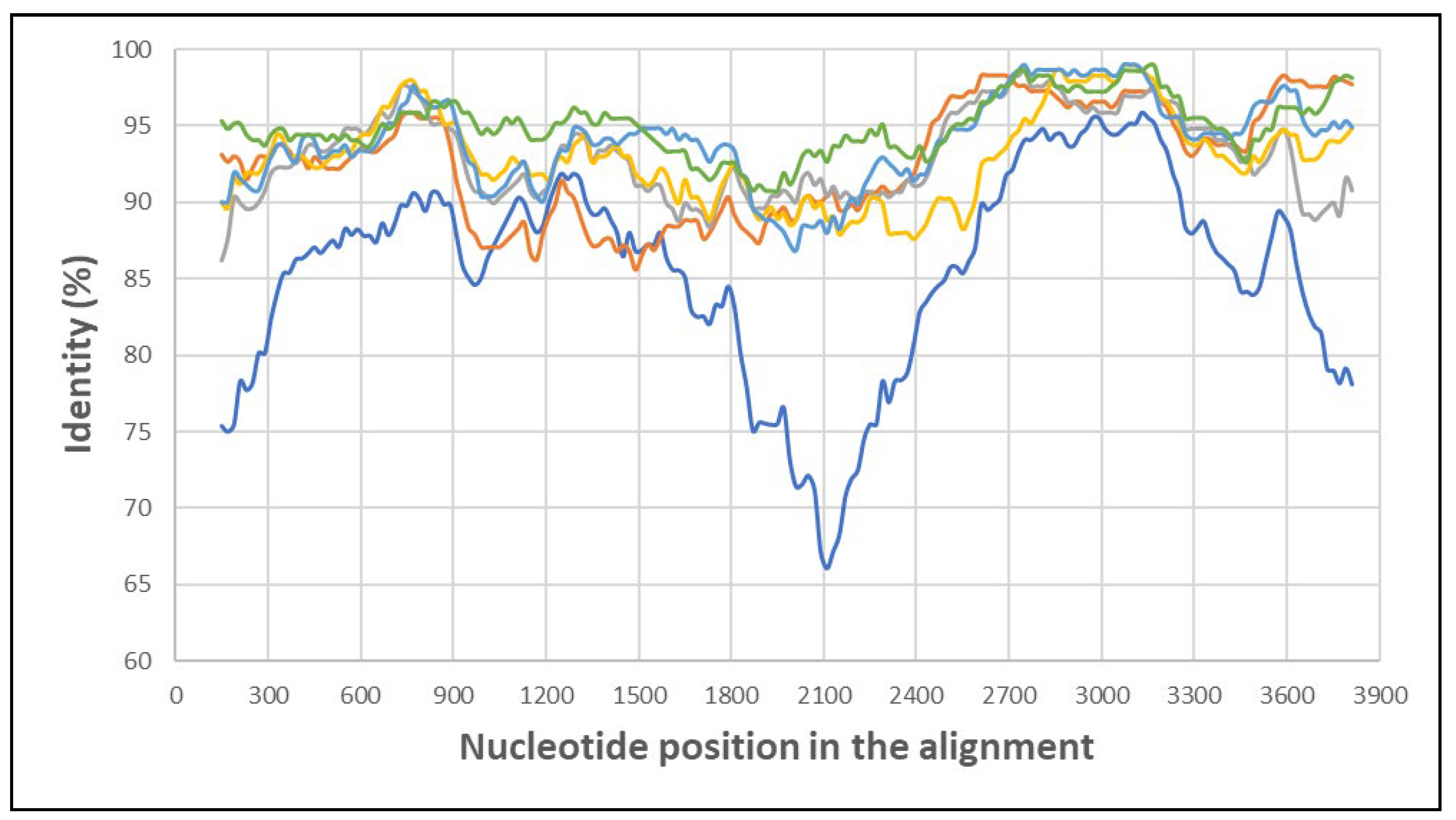
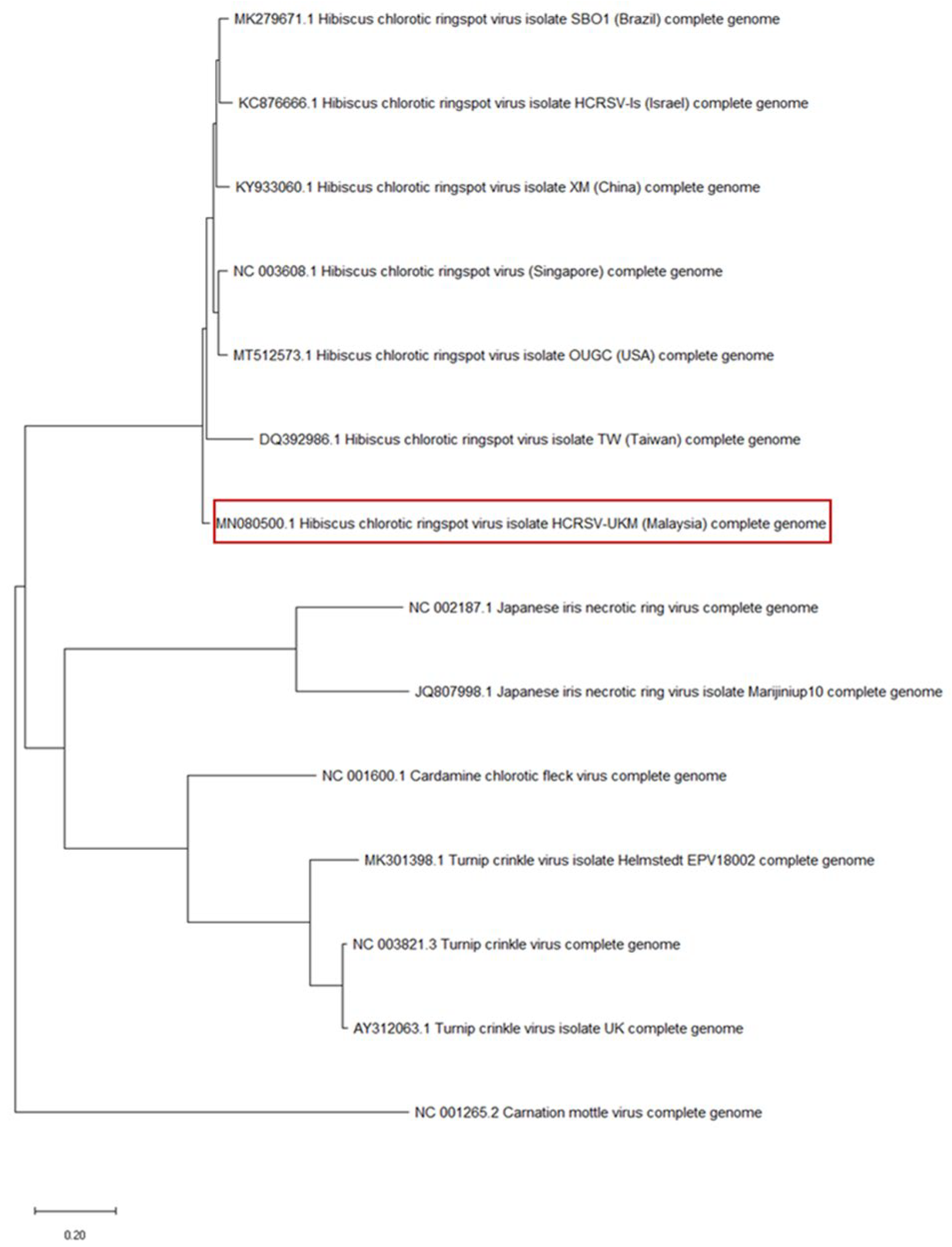
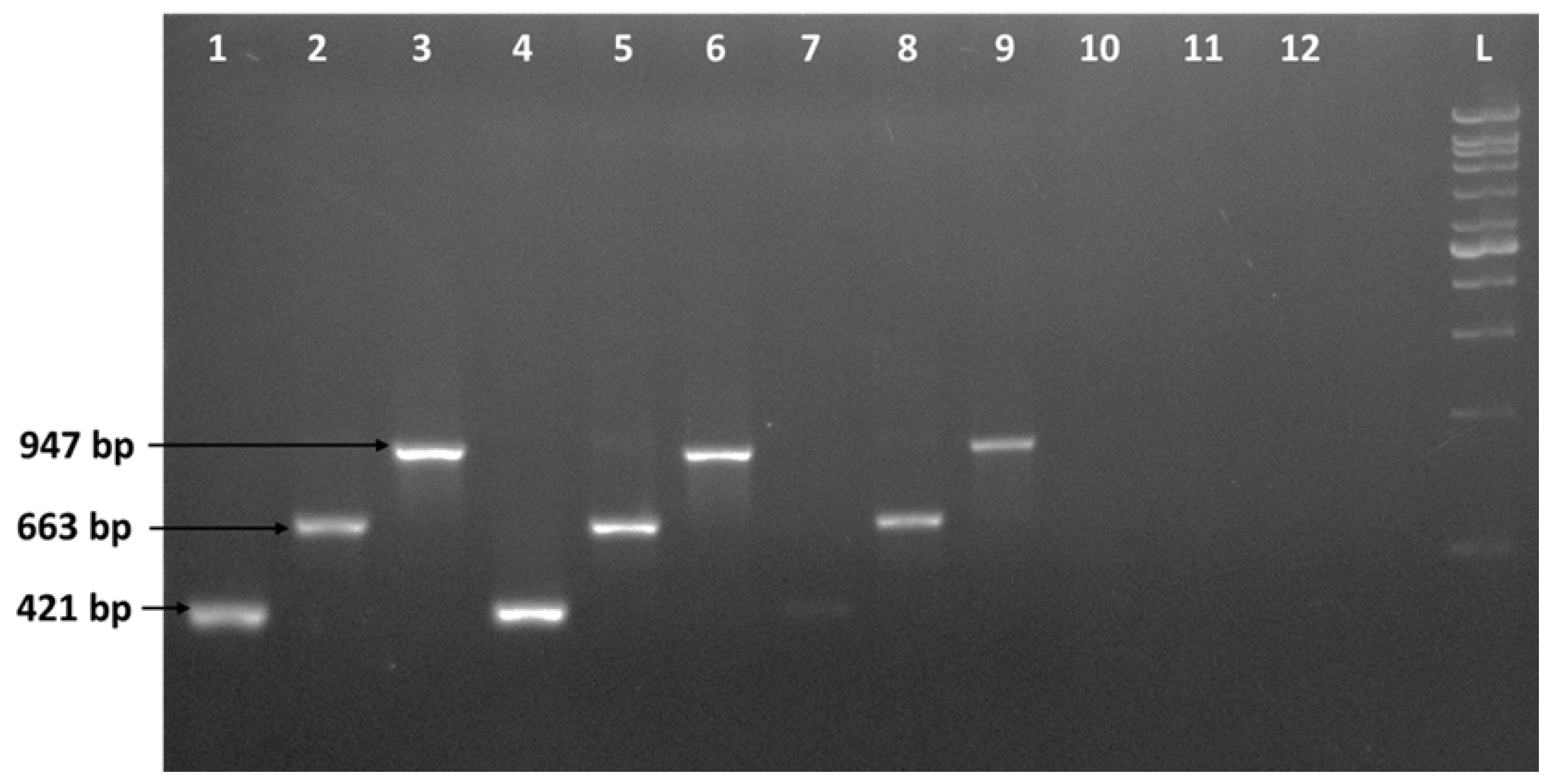
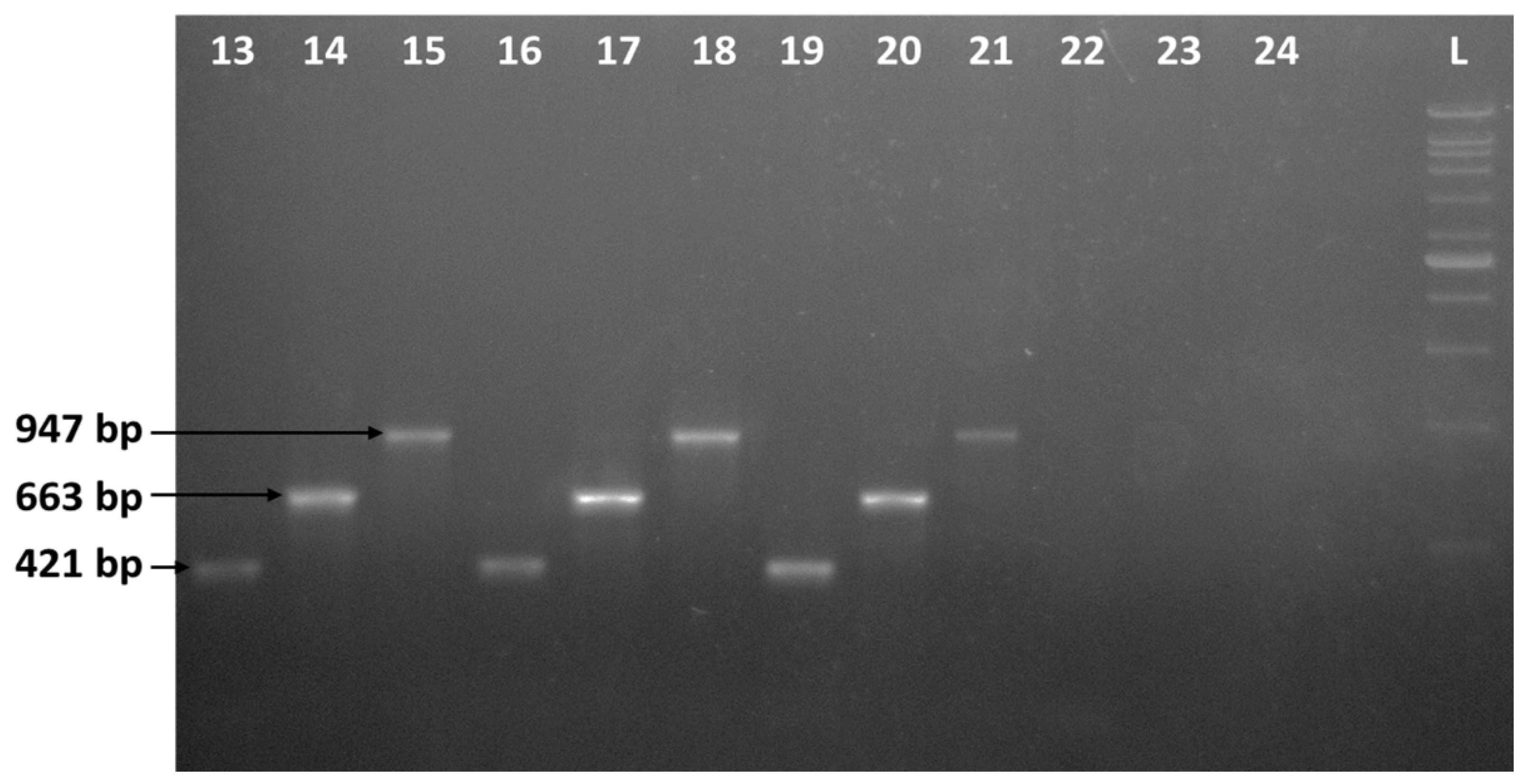



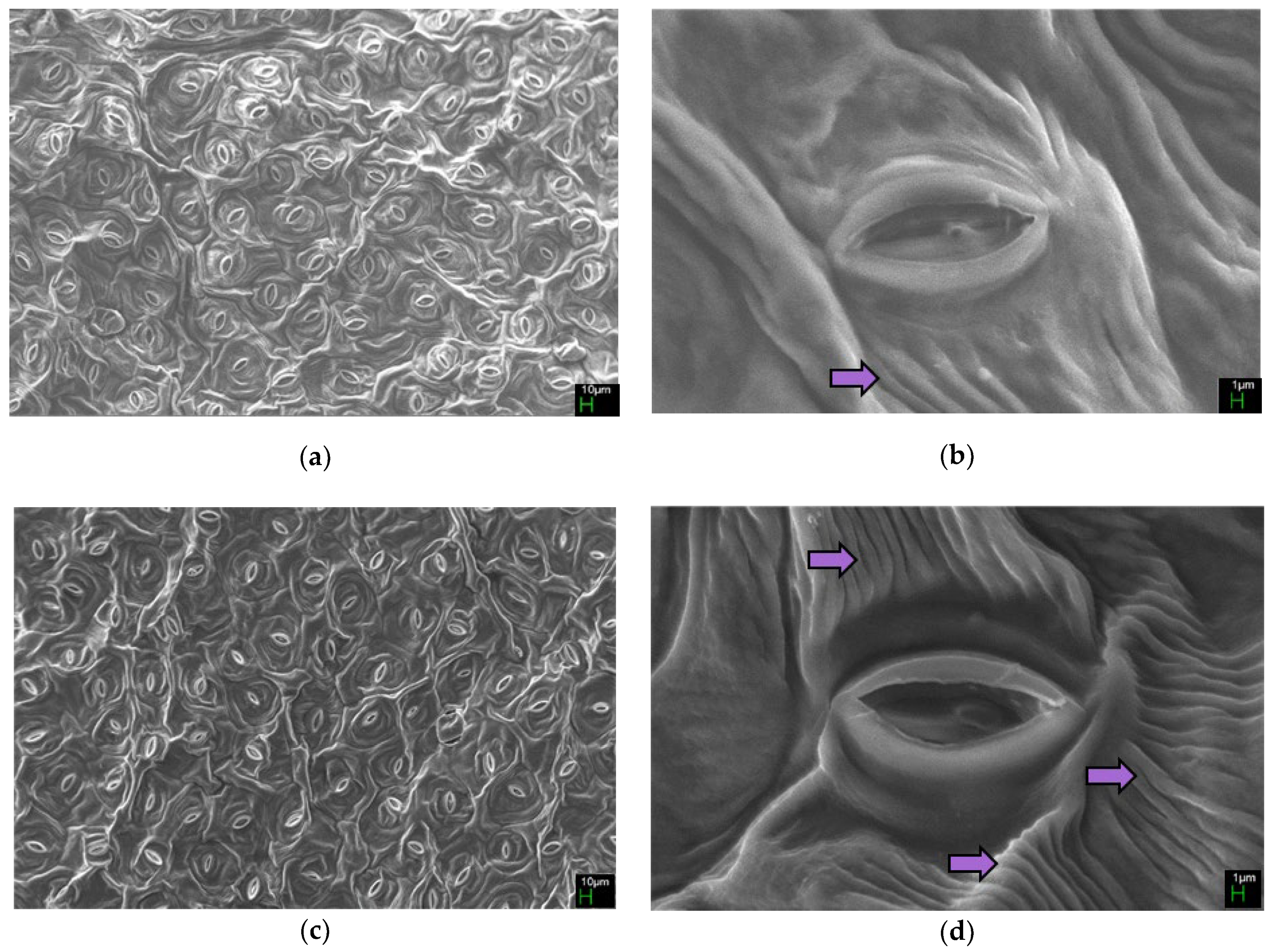
| Symptom | Location (Google Coordinates) | Quantity of Samples |
|---|---|---|
| Foliar chlorotic spots | Bangi, Selangor (2.96641, 101.78868) | 5 |
| UKM, Selangor (2.92528, 101.773) | 5 | |
| Nilai, Negeri Sembilan (2.80842, 101.81312) | 7 | |
| Ipoh, Perak (4.62352, 101.06852) | 4 | |
| Raub, Pahang (3.79353, 101.85746) | 5 | |
| Putrajaya (2.92424, 101.6892) | 5 | |
| Total: 31 |
| No. | Primer Name | Primer Sequence (5′–3′) | Expected Product Size | Target Region |
|---|---|---|---|---|
| 1 | HCRSV-Fwd-1 | CCATTGCGAGTTTGTGGGC | 421 bp | CP |
| HCRSV-Rvs-1 | CACATCCCCTTCAGATTGGC | |||
| 2 | HCRSV-Fwd-2 | CCAGTAGTTCCGACCCTAAGC | 663 bp | CP |
| HCRSV-Rvs-2 | AGCCCACCCGAAGGATTTT | |||
| 3 | HCRSV-Fwd-3 | TGGCCACTCCTCTGGTACTTAC | 947 bp | RdRp |
| HCRSV-Rvs-3 | CGCATCCACAGAAACGTGCTG |
| HCRSV-UKM (MN080500.1) | HCRSV Isolate | |||||
|---|---|---|---|---|---|---|
| Singapore (NC_003608.1) | TW_Taiwan (DQ392986.1) | XM_China (KY933060.1) | Is_Israel (KC876666.1) | SB01_Brazil (MK279671.1) | OUGC_USA (MT512573.1) | |
| Nucleotide sequence (%) | ||||||
| Complete genome | 93.37 | 87.90 | 92.99 | 92.29 | 93.19 | 93.31 |
| Predicted amino acid sequence by ORF (%) | ||||||
| RdRp | 96.32 | 90.15 | 94.82 | 95.91 | 96.19 | 95.78 |
| P28 | 95.79 | 85.05 | 91.12 | 93.46 | 94.86 | 94.86 |
| P23 | 82.74 | 69.42 | 80.00 | 80.71 | 81.22 | 85.79 |
| P9 | 100.00 | 84.62 | 96.15 | 91.38 | 98.72 | 93.10 |
| P8 | 91.43 | 87.14 | 97.14 | 97.14 | 98.57 | 92.86 |
| P25 | 94.20 | 87.50 | 95.09 | 91.96 | 95.98 | 95.09 |
| CP | 96.52 | 95.94 | 97.97 | 93.62 | 97.68 | 97.10 |
Disclaimer/Publisher’s Note: The statements, opinions and data contained in all publications are solely those of the individual author(s) and contributor(s) and not of MDPI and/or the editor(s). MDPI and/or the editor(s) disclaim responsibility for any injury to people or property resulting from any ideas, methods, instructions or products referred to in the content. |
© 2023 by the authors. Licensee MDPI, Basel, Switzerland. This article is an open access article distributed under the terms and conditions of the Creative Commons Attribution (CC BY) license (https://creativecommons.org/licenses/by/4.0/).
Share and Cite
Yusop, M.S.M.; Lanisa, N.; Talip, N.; Mat Saad, M.F.; Abas, A.; Sarian, M.N.; Hamezah, H.S.; Harun, S.; Bunawan, H. The Complete Genome Sequence, Molecular Detection, and Anatomical Analysis of Hibiscus Chlorotic Ringspot Virus Infecting Hibiscus rosa-sinensis in Peninsular Malaysia. Horticulturae 2023, 9, 569. https://doi.org/10.3390/horticulturae9050569
Yusop MSM, Lanisa N, Talip N, Mat Saad MF, Abas A, Sarian MN, Hamezah HS, Harun S, Bunawan H. The Complete Genome Sequence, Molecular Detection, and Anatomical Analysis of Hibiscus Chlorotic Ringspot Virus Infecting Hibiscus rosa-sinensis in Peninsular Malaysia. Horticulturae. 2023; 9(5):569. https://doi.org/10.3390/horticulturae9050569
Chicago/Turabian StyleYusop, Mohd Shakir Mohamad, Normawati Lanisa, Noraini Talip, Mohd Faiz Mat Saad, Azlan Abas, Murni Nazira Sarian, Hamizah Shahirah Hamezah, Sarahani Harun, and Hamidun Bunawan. 2023. "The Complete Genome Sequence, Molecular Detection, and Anatomical Analysis of Hibiscus Chlorotic Ringspot Virus Infecting Hibiscus rosa-sinensis in Peninsular Malaysia" Horticulturae 9, no. 5: 569. https://doi.org/10.3390/horticulturae9050569
APA StyleYusop, M. S. M., Lanisa, N., Talip, N., Mat Saad, M. F., Abas, A., Sarian, M. N., Hamezah, H. S., Harun, S., & Bunawan, H. (2023). The Complete Genome Sequence, Molecular Detection, and Anatomical Analysis of Hibiscus Chlorotic Ringspot Virus Infecting Hibiscus rosa-sinensis in Peninsular Malaysia. Horticulturae, 9(5), 569. https://doi.org/10.3390/horticulturae9050569









